Bulletin – September 2008 Oil Prices and the Australian Economy[1]
- Download 57KB
Introduction
Oil prices rose to a peak of US$145 per barrel in July and are currently trading at close to US$100. Despite the recent moderation, the current (US dollar) price is around 30 per cent higher than a year ago, and more than 250 per cent above the level five years ago. While the appreciation of the Australian dollar over recent years has helped to lessen somewhat the effect on Australian businesses and consumers, Australian dollar oil prices – in real terms – are nonetheless now around their highest levels on record (Graph 1).[2] This article discusses the forces behind the sharp increase in oil prices in recent years and the impact of higher oil prices on the Australian economy.
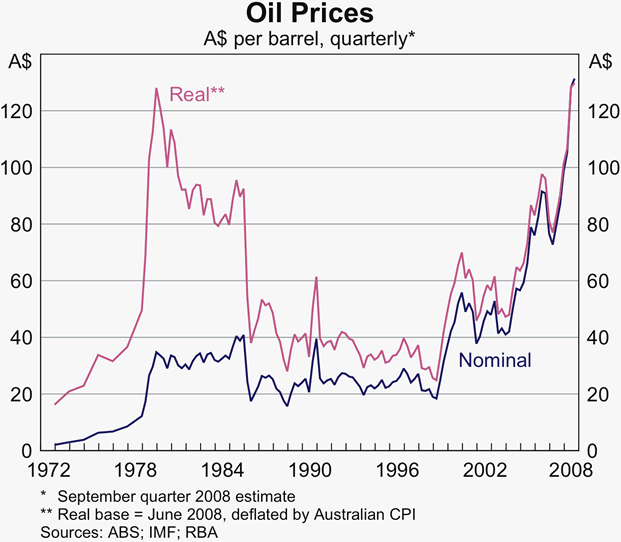
Oil Intensity and Expenditure
Oil is used widely throughout the economy, both as a consumption good and as an input into the production process. For the Australian economy as a whole, the importance of oil has declined over time, with the volume of oil consumed per unit of real GDP now around 40 per cent below that during the second OPEC oil price shock in 1980 (Graph 2). A similar pattern is also observable in other industrialised economies, reflecting the growing importance of the services sector (which is less energy-intensive) relative to the goods-producing sectors and the more efficient use of oil by firms and households in response to the sharp increases in prices in the 1970s and early 1980s.
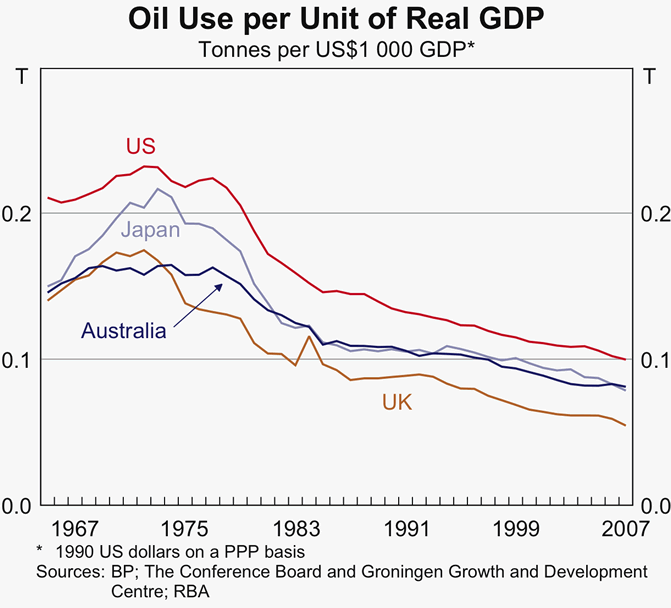
Despite the common trend toward lower oil usage, the intensity of oil use varies somewhat across industrialised economies. This reflects a number of factors, including the range of uses within their economies. For example, while transportation accounts for more than 80 per cent of oil use in the Australian economy, this proportion tends to be lower in many other countries, particularly those that use oil extensively for heating and non-energy purposes (such as in the manufacture of plastics). The extent to which oil usage is concentrated in transportation also reflects cross-country differences in geographic dispersion and public transport networks.
Although oil prices have risen sharply over the past five years, given the large multi-decade fall in Australia's intensity of oil use, total domestic expenditure on oil as a share of GDP remains below the levels seen in the late 1970s and early 1980s (Graph 3). Having peaked briefly at 6 per cent of GDP in 1980, spending on oil declined to less than 2 per cent of GDP in the late 1980s and remained low throughout the 1990s. Spending on oil is estimated to have since returned to around 4 per cent of GDP. While still lower than its level in the 1970s, this implies a significant reduction in real household purchasing power in recent years due to higher oil prices.
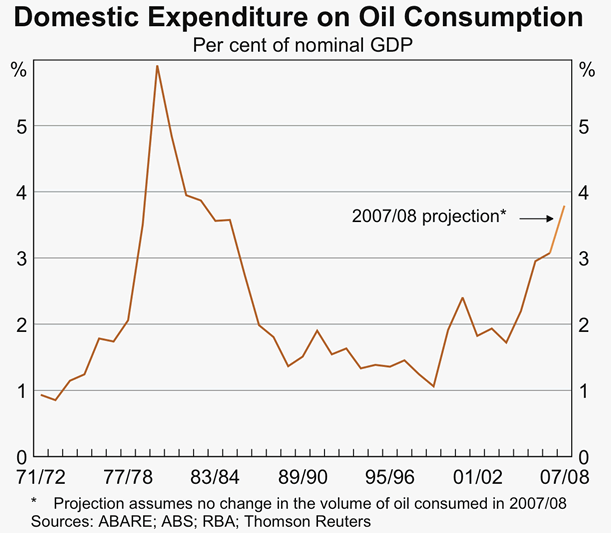
Global Supply and Demand Developments
The causes and international environment associated with the current high level of oil prices are quite different from those that supported high prices in previous decades. While the oil shocks of the 1970s largely reflected a supply shock that led to a rapid escalation in prices, the recent sustained upward trend in prices has reflected a strong increase in demand against a backdrop of a weak supply-side response.
On the demand side, rapid economic growth in emerging economies has been associated with increasing usage of oil per capita in these economies. China alone is estimated to account for around one-third of the increase in global oil consumption over the past few years, and there have also been significant increases in other emerging regions (Graph 4). Demand for oil in many developing countries has also been supported by government subsidies that restrict the pass-through of high crude prices to the retail price of petroleum products. Meanwhile, oil demand in the industrialised economies has not been particularly sensitive to price increases in the short run, thus resulting in only modest falls in OECD consumption over the same period.
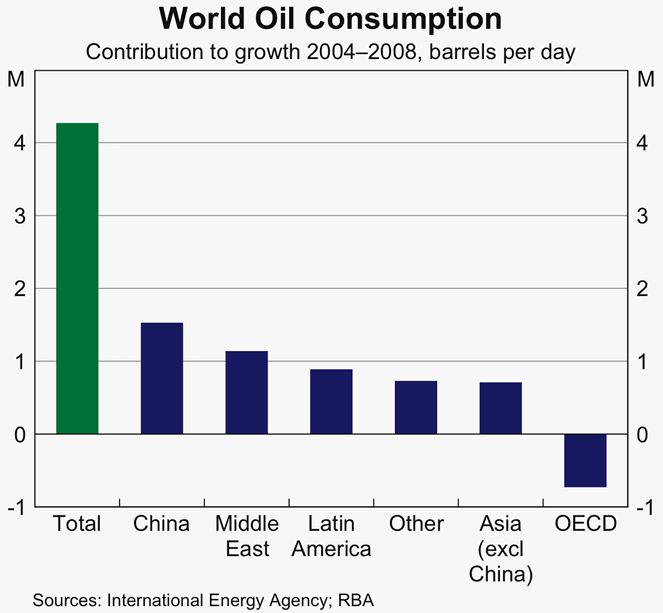
The anticipation of continuing strong increases in demand in emerging economies is also likely to be a factor in the current elevated level of oil prices. The potential for oil demand growth in countries such as China and India is illustrated by the development experience of South Korea and Japan, where the early phases of their economic expansion coincided with a rapid increase in oil use per capita (Graph 5). In addition, although per capita oil consumption in China and India remains low relative to that in the industrialised economies, small increases in per capita consumption in these countries make significant contributions to world demand due to the large size of their populations.
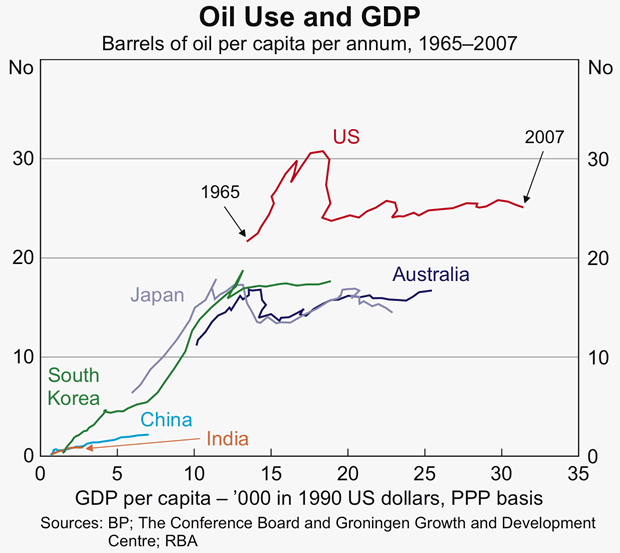
While demand for oil from emerging economies has increased noticeably, the increase in supply in recent years has been low. According to the US Department of Energy, global oil production increased at an average annual rate of around ½ per cent a year between 2004 and 2007, compared with an annual rate of close to 2 per cent over the previous decade (Graph 6). The low rate of supply growth reflects limited increases in OPEC production and a trend decline in OECD production as fields are depleted (including in Australia), while supply growth in other producing regions (such as the former Soviet Union) has been lower than expected. Furthermore, OPEC spare capacity has declined compared with levels seen earlier in this decade, while the development of new oil fields globally is constrained by a number of factors including rising costs and political uncertainty. In particular, oil companies face strong competition for labour and materials from other resource sectors, resulting in a rapid escalation of development costs over recent years, while much of the world's oil reserves are held in regions where the political environment may limit investment.
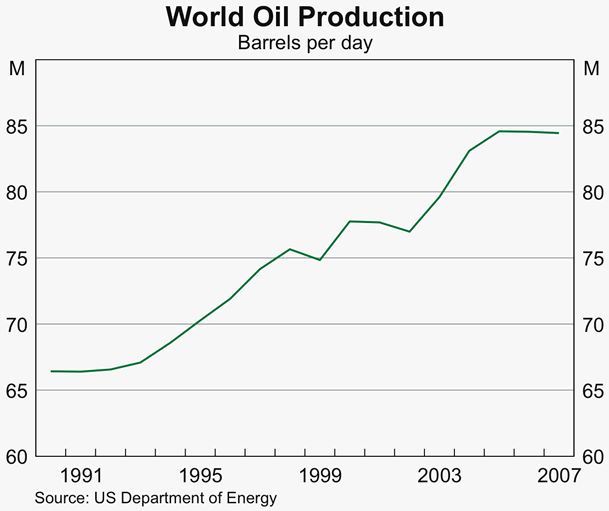
Implications for the Australian Economy
One way to gauge the effect of higher oil prices on the Australian economy is through the trade balance in oil-related products. For economies that are net importers of oil, an increase in the price of oil could be expected to reduce the purchasing power of national income. In recent decades, Australia has tended to run a small deficit in the trade of oil-related products, with imports slightly exceeding exports. Since 2000, as domestic oil field production has declined and prices have increased, this deficit has expanded, reaching over 1 per cent of nominal GDP in 2007 (Table 1). While this implies a rising negative impact of oil price rises on our domestic purchasing power, some of the factors driving up oil prices – such as strong domestic growth in developing Asia – have also underpinned large price increases for Australia's major energy exports, such as coal and natural gas.[3] Indeed, Australia's overall energy trade balance – which takes these latter commodities into account – shows a surplus that has increased over recent periods, as sharp rises in coal export earnings in particular have more than offset the decline in Australia's oil trade balance.
| 1990–1999 | 2000–2006 | 2007 | June quarter 2008 |
|
|---|---|---|---|---|
| Oil exports | 0.6 | 1.0 | 0.9 | 1.1 |
| Oil imports | 0.8 | 1.5 | 2.2 | 3.0 |
| Net oil position | −0.2 | −0.5 | −1.2 | −1.8 |
| Coal & gas exports | 1.8 | 2.2 | 2.5 | 4.0 |
| Net energy position | 1.6 | 1.7 | 1.2 | 2.1 |
|
Source: ABS |
||||
However, the benefits of higher export receipts resulting from the increase in global commodity prices take some time to flow through the economy, whereas households and oil- intensive sectors feel the negative effects of rising prices on real disposable incomes almost immediately. Average capital city petrol prices have risen by around 25 per cent over the past year and by 70 per cent since 2003 (Graph 7). Given that the average household consumes around 32 litres of petrol per week, the increase over the past year amounts to nearly $10 a week additional expenditure on petrol. This takes the average total weekly petrol bill to almost $50 per household, or 3 per cent of current average household disposable income.[4]
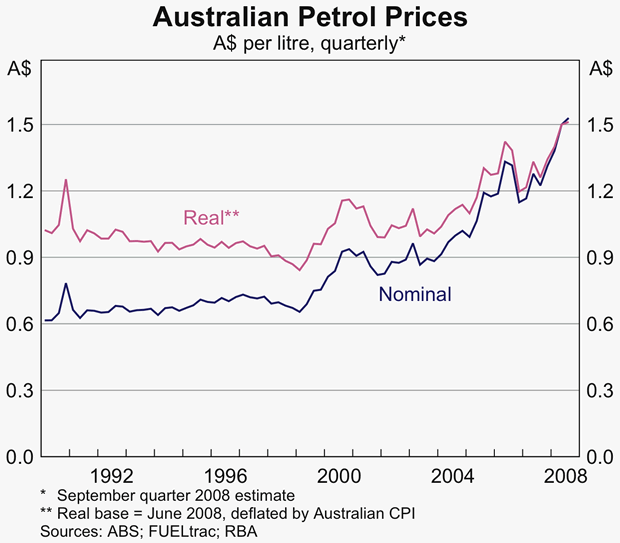
Studies suggest that fuel usage is relatively insensitive to changes in prices in the short run. However, there is some tentative evidence that fuel consumption is now being reduced in response to these high prices. For example, data on toll road usage in Sydney and Melbourne suggest that growth of traffic volumes has slowed a little, there is evidence that the use of public transport has picked up, and the volume of automotive fuel sales shows signs of weakening in the first half of 2008.
A clearer example of the adjustment in response to high fuel prices over recent years has been the substantial increase in the proportion of smaller cars sold compared with SUVs and large passenger vehicles (Graph 8). Nevertheless, given that the average age of a vehicle on the roads is around 10 years, this change in purchasing patterns, even if sustained, would take some time to be significantly reflected in the composition of Australia's vehicle fleet and hence to have much effect on aggregate fuel consumption. This is also the case for the capital stock more generally, and helps to explain why the recent large run-up in oil prices is yet to produce much of a recorded fall in the intensity of oil use in the economy in recent years.
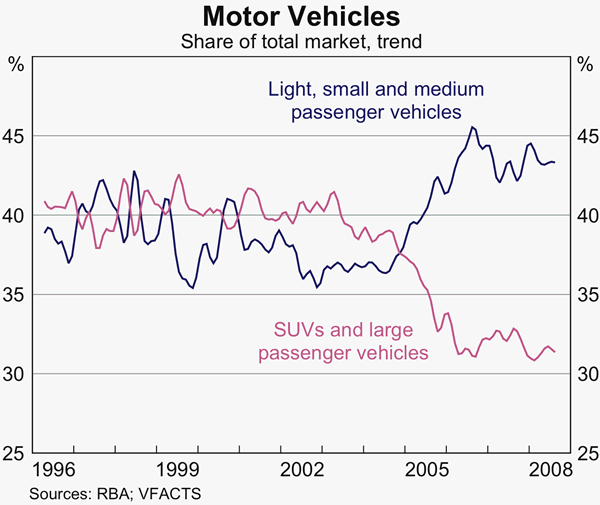
Summary
Although the intensity with which oil is used in the economy has declined since the 1970s, the recent increase in oil prices has resulted in a noticeable increase in Australia's expenditure on oil. On its own, the strong increase in prices represents a significant negative shock to the economy, particularly given Australia's increased reliance on oil imports over this decade. Over time these price increases would be expected to lead to a gradual reduction in oil usage. However, the forces driving up oil prices have also underpinned strong price increases for other commodities, such as coal, iron ore and natural gas. Accordingly, the current increase in oil prices is part of a broader set of relative price changes. From this perspective, the run-up in oil prices may represent less of a shock to the Australian economy than during earlier global oil shocks.
Footnotes
This article was prepared by Tom Rosewall, Robert Arculus and Callam Pickering of Economic Analysis Department. It updates the discussion in a previous Bulletin article, ‘Oil Market Developments and Macroeconomic Implications’, RBA Bulletin, October 2004, pp 1–8. [1]
The price of domestically produced oil was largely fixed at below-market levels until August 1975, so Australian oil consumers were partially insulated from the direct price effects of the first OPEC price shock. Prices for domestically produced oil were increased towards world prices over the following three years, with the shift to import parity pricing completed in the August 1978 Budget announcement. [2]
For details, see ‘Australian Exports and Developing Asia’, RBA Bulletin, June 2008, pp 1–11. [3]
Based on unpublished national accounts data on fuel consumption. The rise in petrol prices has had a significant effect on headline inflation, contributing 0.8 percentage points to CPI inflation over the year to the June quarter 2008. This represents the direct effect of higher petrol prices on the CPI. Second-round effects, such as increases in the cost of goods and services that use oil products as an input, are also likely to be significant, but are difficult to measure. [4]